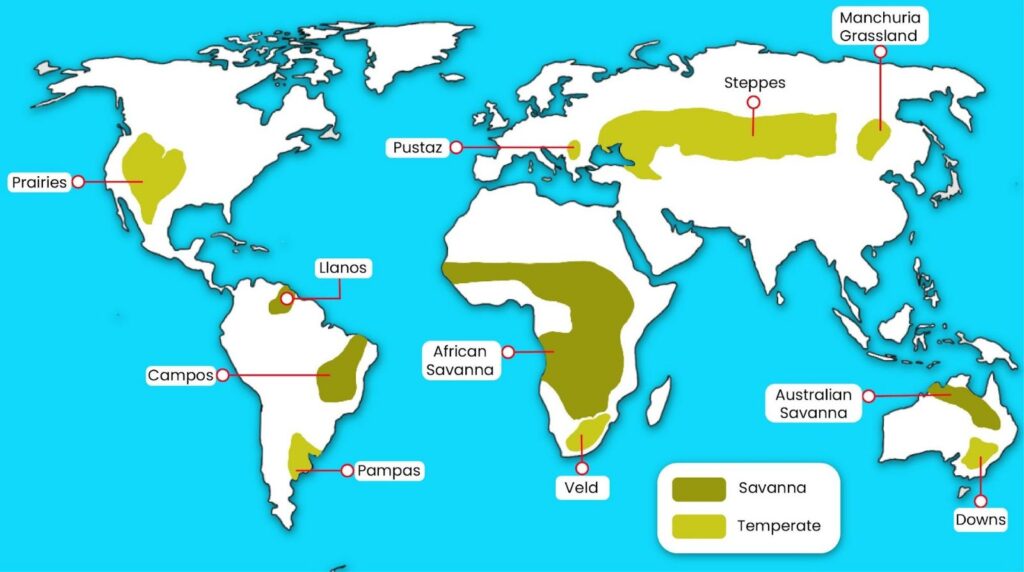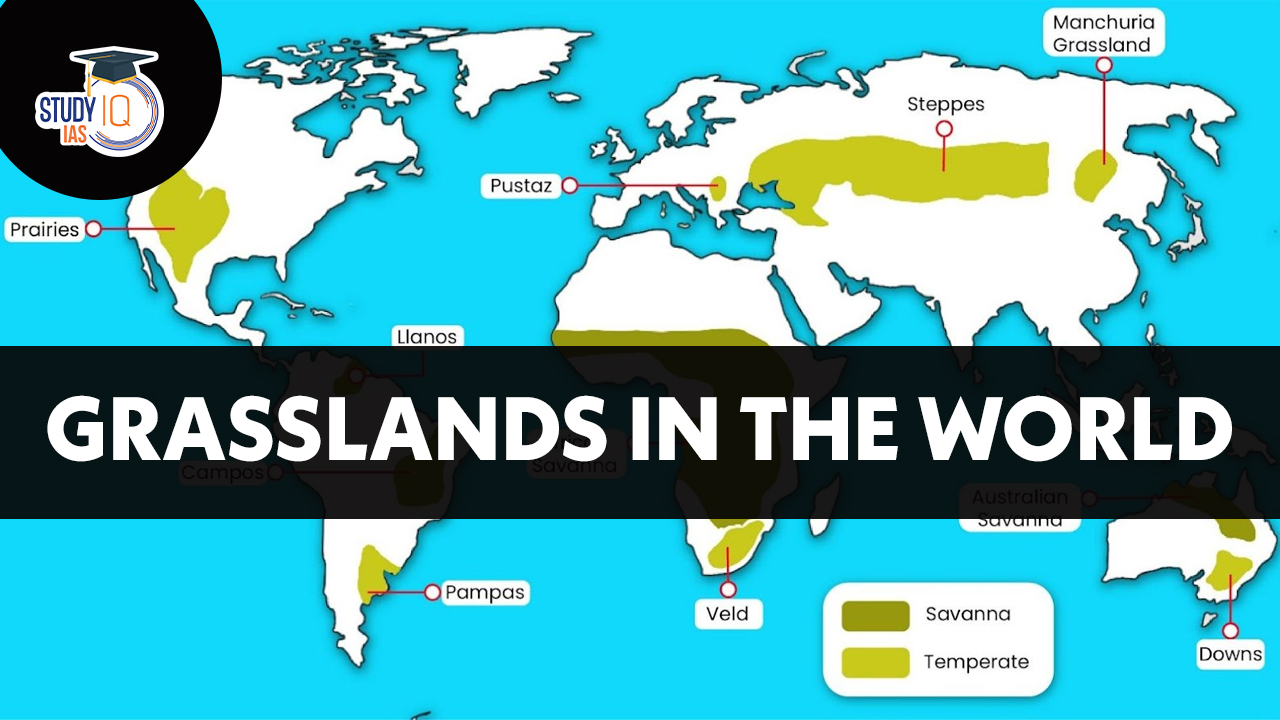Table of Contents
Grasslands are large terrestrial ecosystems with grasses dominant, with discontinuous trees and shrubs (particularly in tropical forms) or extremely few trees (in temperate forms). They occupy every continent except Antarctica and constitute a large proportion of the land area on Earth, with important influences on global ecology and sustaining human populations.
Grasslands in the World
In many parts of the world, there are big areas covered in grass instead of trees or forests. These places are called grasslands. They are like nature’s open fields where different plants and animals live. This article explores these grasslands and discovers the special world they hold.
What is Grassland?
A grassland, in geographical terms, is a type of ecosystem characterized by open spaces covered primarily with various types of grasses and other non-woody plants. Unlike forests, which are dominated by trees, grasslands have a more open landscape with scattered trees or no trees at all. The vegetation in grasslands is adapted to thrive in areas with moderate rainfall and seasonal variations. The soil in grasslands is usually fertile, which supports the growth of different types of grasses and plants.
List of Grasslands in the World
Here is a comprehensive table that highlights different types of Grasslands in the World.
| Types of Grasslands in the World | ||||
| S.No | Name | Region | Characteristics | Economic Importance |
| 1 | Savannas | Africa, South America, Australia | Mix of grasses and scattered trees | Grazing, ecotourism, and biodiversity preservation |
| 2 | Steppes | Eurasia | Large, flat expanses, semi-arid conditions | Grazing, agriculture |
| 3 | Pampas | South America | Rich soil, moderate rainfall | Cattle ranching, agriculture |
| 4 | Prairie | North America | Fertile soil, varying precipitation | Agriculture, grazing |
| 5 | Veld | Southern Africa | Diversity of grasses, variable rainfall | Grazing, agriculture |
| 6 | Downs | Australia, New Zealand | Rolling hills, grass-dominated | Grazing, agriculture |
| 7 | Campos | South America | Wet and dry seasons, shrubs and grasses | Grazing, agriculture |
| 8 | Pustaz Grasslands | Eurasia | Semi-arid, grasses and herbs | Grazing, biodiversity conservation |
| 9 | Manchuria Grasslands | China, Russia | Cold climate, mixed grass and shrubs | Grazing, traditional land use |
Types of Grasslands in the World
Grasslands are broadly classified into two broad categories according to their climate:
Tropical Grasslands (Savannas)
- Climate: Hot throughout the year with clear wet and dry seasons. They have moderate to high rainfall (50-150 cm per year), yet it’s focused within a limited time.
- Vegetation: Dominated by tall grasses, sometimes dotted with scattered trees (such as acacia and baobab) and shrubs that are well adapted to fire and drought.
- Location: Encountered in areas between deserts and tropical forests, mostly in:
- Africa: East and Central Africa (e.g., Serengeti, Maasai Mara) extensive savannas, Southern Africa (e.g., Miombo Woodlands, Sahelian Acacia Savanna).
- South America: Llanos of Venezuela and Colombia, Campos and Cerrado of Brazil, portions of Bolivia and Paraguay.
- Australia: Australian Savanna of Northern Australia.
- Asia: Portions of India (Terai-Duar Savanna).
Temperate Grasslands
- Climate: Have a clear warm and cold season, with temperatures below freezing during winter. Have moderate amounts of rainfall (25-75 cm per year) that is more evenly distributed than savannas, which tend to fall as snow in winter.
- Vegetation: Grasses and wildflowers dominate, with few to no trees except near river valleys. Grass height changes with rainfall (tallgrass prairies in more wet areas, shortgrass prairies in more dry areas).
- Location: Occurs in mid-latitudes, usually continental interiors, including:
- North America: Prairies (Central USA and Canada).
- South America: Pampas (Argentina, Uruguay, and parts of Brazil).
- Eurasia: Steppes (Eastern Europe, Russia, Ukraine, Kazakhstan, Mongolia, and northern China, constituting the enormous Eurasian Steppe). Pustaz (Hungary) is a special kind of steppe.
- Africa: Veld (Southern Africa, notably South Africa).
- Australia: Downs (Southeastern Australia).
- New Zealand: Canterbury Plains (South Island).
Other Types of Grasslands
Outside of the two broad categories, there are other specialized grasslands:
- Montane Grasslands: Occur at high elevations in mountains (e.g., Tibetan Plateau, Andean Páramo).
- Flooded Grasslands: Temporarily or perennially flooded (e.g., Pantanal in South America, Everglades in Florida).
- Desert Grasslands: Open grasslands on the fringes of deserts, adapted to dry conditions.
- Shrublands: Characterized by woody or herbaceous shrubs, frequently with a mix of grasses.
Map of Grasslands in the World

Significance of Grasslands
Grasslands are critical ecosystems, yielding many ecological, economic, and social values:
- Biodiversity Hotspots: They harbor an amazing array of plant and animal species, such as many of the world’s iconic large mammals (e.g., bison, zebras, lions, rhinos, kangaroos) and many bird, reptile, amphibian, and insect species. Many are biodiversity hotspots.
- Carbon Sequestration: Grasslands are major carbon sinks, holding more than 30% of the earth’s carbon stores in their deep root systems and soils. For this reason, they play a key role in limiting climate change, and they can be as stable a carbon store as forests because they are fire and drought-resistant.
- Soil Erosion Control and Soil Health: The expansive grass roots anchor the soil, holding back water and wind erosion, and sustaining soil health.
- Water Regulation: Grasslands allow rainwater to infiltrate into the soil, refreshing groundwater resources and controlling the flow of water into rivers and streams, which will abate floods. They also filter out contaminants naturally from water.
- Livelihoods and Food Security: More than a billion people, such as pastoralists, smallholder farmers, and indigenous peoples, directly rely on grasslands for their livelihoods and food. They serve as fodder for grazing livestock (meat, milk, wool, leather), and their fertile lands are essential for planting staple foods such as wheat and corn.
- Cultural Significance: Grasslands have influenced the nomadic and pastoral way of life of many indigenous peoples across the globe and are of great cultural importance.
- Economic Value: They contribute significantly to the global economy through livestock production, agriculture, and eco-tourism.
Food Chain in the Grasslands
In the geographical context of a grassland ecosystem, a food chain illustrates how energy and nutrients flow from one living organism to another. In grasslands, the food chain typically starts with producers, organisms that create their own food through photosynthesis. These producers include various types of grasses and plants.
Herbivores, the animals that eat plants, form the next level of the food chain. In grasslands, herbivores can include animals like zebras, antelopes, and bison, which graze on the abundant grasses and plants.
Carnivores come next in the food chain. These are animals that eat other animals. In grasslands, carnivores include predators like lions, cheetahs, and wolves, which feed on the herbivores.
At the top of the food chain, there can be apex predators. These are carnivores that don’t have natural predators themselves. In some grassland ecosystems, apex predators can be animals like lions, which are at the highest level of the food chain.
The food chain in a grassland ecosystem demonstrates the interconnectedness of different organisms and how energy is transferred through the ecosystem. Producers capture energy from the sun, herbivores consume the producers, carnivores eat herbivores, and apex predators, if present, occupy the highest position in this chain. This complex interaction of organisms contributes to the balance and functioning of the grassland ecosystem on a geographical scale.
| Related Articles | |
| Types of Rocks | Plateaus in India |
| Northern Plains of India | Rivers of India |
| Pressure Belt of Earth | Tropic of Cancer and Capricorn |


 Places in News for UPSC 2026 for Prelims...
Places in News for UPSC 2026 for Prelims...
 Lake Natron: Location, Features, Wildlif...
Lake Natron: Location, Features, Wildlif...
 Erra Matti Dibbalu Added to UNESCO Tenta...
Erra Matti Dibbalu Added to UNESCO Tenta...

























